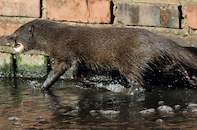
Name
Water mongoose, marsh mongoose (Atilax paludinosus)Appearance
The water mongoose is a large and sturdy-bodied animal, measuring 800 to 1000 mm in length with a weight of 2.5 to 4.2 kg. Their tails are about 300 to 410 mm long and covered in long, bushy hairs. They are dark brown in colour overall with a lighter coloured nose.
The water mongoose has a large head, ears closely pressed against it, and a short muzzle. Because of their large brains, they have very well developed tactile sensitivity and muscular control of their forepaws, enabling these semi-aquatic creatures to find and eat crabs and other hard-bodied prey.
The teeth of the water mongoose are adapted to crushing the hard shells of shellfish as opposed to shearing it. This is the only member of the Herpestidae family with unwebbed feet, keeping their grip on soft substrates by splaying their toes, leaving a very identifiable spoor.
Diet
The water mongoose predominantly feeds on aquatic prey such as prawns, fish, crabs and frogs at times. They have also been regularly reported to take the cane rat, dassie and blue duiker as prey, but whether these animals are hunted or scavenged by the water mongoose is unestablished.Breeding
Little is known about the water mongoose’s sexual behaviours. Females birth two young per litter, although three young in a litter have been reported. She builds a nest of dry grass in a hole or a raised nest of sticks, reeds and grass in swampy areas where there are no holes.
The young open their ears and eyes at ten days of age and take food at one month. They are weaned at a few months of age, after which they leave their birthplace.
Water mongoose breed twice a year in South Africa – once during the dry season and then during the rainy months. A second adult can accompany the family at times.
Behaviour
The water mongoose is a nocturnal animal, solitary in habits and semi-aquatic. Those that inhabit marshes have established habits, following pathways that have been well defined and smooth. These pathways are often covered by tall grass and reeds, and follow shorelines or rivers. They are very territorial over their linear areas of land spread along their habitat.
The water mongoose catches birds by lying on its back, pretending to sunbathe. Its anal area appears particularly prominent when in this position, being a pale pink in colour against its dark brown fur.
This performance is said to attract birds to peck at the anal area, whereupon the mongoose quickly snatches it. When a threat nears, it sounds a low growl followed by deeper, eruptive barking growls. It squirts a foul brown fluid from its anal sacs when alarmed or cornered. When excited, it sounds a high-pitched shriek or an open-mouthed bleat. They are most often spotted unaccompanied.